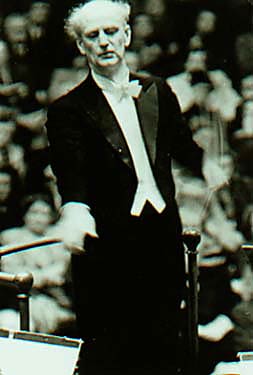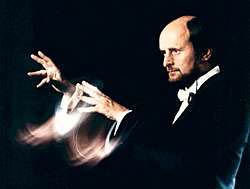Norrington versus Furtwängler: Two Versions of the Ninth by Ewelina Boczkowska
/ May 1, 2002
Version française...
"Deflecting the attention from meaning to
structure [as Norrington does] has been the primary means of resisting the
Ninth," is the central idea of Taruskin's critique.
The very first performance of Beethoven's Ninth
Symphony took place on May 7, 1824, at the Kärnthnerthor Theatre, as the
last feature of a heroic program. Beethoven, who was completely deaf by that
time, conducted the piece with the original score in front of him. The
orchestra, however, followed the conductor, Mr. Schuppanzig. The overflowing
concert hall was an attestation to the audience's admiration, but was that
admiration in recognition of the music heard during one of the finest of
premieres, or was it simply the result of curiosity about the great man himself?
In any case, the applause was thunderous. Critics commented about the innovative
finale that "it requires to be heard frequently in order to be duly
appreciated." Today, almost 180 years later, we still have not heard enough of
the last movement or of the entire symphony.
Although the Symphony has been thoroughly analysed, the
question of how to perform it still remains pertinent. The symphony is a
demanding enterprise when one wishes to understand the composer's intentions. It
raises even more questions as it constitutes the breaking point between
Classicism and Romanticism--fitting both categories yet not entirely appropriate
to either one. Consequently it allows enough room for such different
interpretations as those of Roger Norrington and Wilhelm Furtwängler.
Norrington's interpretation at the Hoffnung Music Festival
is considered "classical." The conductor wants to "restore" the Ninth as
the "quicksilver" of the Classical Period, "not according to recent
interpretative tradition" but instead, to that of the past. His musicians even
play on period instruments. However, the very way Norrington pictures the
beginning of the nineteenth century, in terms of "wit and humour," is the way
one interprets that period nowadays. His "restorative element" suits our
contemporary idea of Classicism.
To remain loyal to what he believes was Beethoven's
unquestionable will, Norrington follows with exemplary rigour all the tempi and
expression marks indicated in the score. The overall result sounds, as Richard
Taruskin puts it in his critique Resisting the Ninth, like an "advancing
army." The surface effect is clearly detectable in the third movement: where one
is supposed to hear an explicit dialogue between the strings and brass, as
indicated in the score, Norrington goes so fast that the moment is easily
missed. One might as well conclude that Norrington has to complete the symphony
within 62:23 minutes because he has an important rendez-vous afterwards!
Moreover, he transforms most of the rhythmic motifs into "sound-analog"
distinctively perceptible motifs. The listener can recognise them each time they
appear in the work. Yet, by getting too close to the work, the conductor may
lose the sense of the entire piece. By taking refuge in the "pack of notes,"
Norrington is a prime example of someone resisting the Ninth as he fails
to bring alive the internal meanings, the "brotherhood," the "Elysian desirum,"
or whatever one finds in the Symphony for oneself.
From a completely different standpoint, Furtwängler seems to
have seized those meanings. His Wagnerian romantic influence echoes in the tone,
in the frequent changes of tempi, as well as in the bright dynamics throughout
the interpretation. Furtwängler's orchestra sounds more lyrical than
Norrington's. His performance was recorded live at the 1951 Bayreuth Festival.
If the conductor had lived longer (he died in 1954), he might have registered a
studio version of the Ninth. While Norrigton's performance is neat and
clear--certainly the choral part is without comparison--Furtwängler's has to
cope with people coughing in the background.
Furtwängler's tempi seem to follow the conductor's élan,
influenced by the emotions emanating from the score. This choice is also based
on the dialogues between different instrumental layers. A clear example is a
passage at the beginning of the Adagio, which might seems very slow but brings
out the discussion between the strings and brass. The conductor plays with the
dynamic indications as well: his crescendos are very pronounced. The forte in
measure 24 of the first movement is anything but subtle. Furthermore,
Furtwängler's reading is characteristic for its use of pauses between the
movements. While Norrington never seems to stop, the German conductor's silences
suspend the listener, making him anxious to hear what follows; the Ninth
sounds like an auditory thriller in series – after hearing one part, we listen
intensely for more. Those suspensions contribute to bringing out the "sublime"
that Furtwängler builds up from the beginning, to finally let it explode in the
fourth movement. Indeed, when Furtwängler brings about changes in
interpretation, it is to transmit an accentuated message. He transmits
Beethoven's hope for a better tomorrow; this is where Norrington
fails.
The delivery of the fourth movement by both conductors is
different in nearly all respects. Norrington's Ode To Joy is a metric ecstasy
that leaves one feeling at ease and happy. The bass moves on; the melismas are
executed at a steady tempo. The choir joins in with an impeccable elocution (the
words of the ode can be understood). On the other hand, Furtwängler announces
the theme of joy suspiciously: there is a sudden break after the blissful Vivace
so that the entrance of the basses at Tempo 1 sounds astonishingly dramatic.
There is indeed a dual meaning to Furtwängler's idea of joy: it is joy with an
afterthought. When the bass soloist sings for the first time and is interrupted
by a clear chromatic short passage in the strings (a detail not worth a comment
by Norrington), it promises the joy to come. The melismas go on forever. In
Allegro assai, the instruments gradually join each other and when the choir
enters, everything becomes not just victorious but joyful. It sounds like a
demonic party joined by a gang of people who sing words, whatever their clarity
may be.
"Deflecting the attention from meaning to structure [as
Norrington does] has been the primary means of resisting the Ninth ," is
the central idea of Taruskin's critique. One could argue that respective social
contexts influenced the two conductors' interpretations. Furtwängler's
performance took place in 1952, Norrington's in the 1980s. The meaning of the
Ninth for Furtwängler is the salvation, the brotherhood and the freedom
that come after difficult times. The way he conducted it was likely to have been
inspired by the War and could have been a result of the nation's need for a
burst of hope and rebirth. Perhaps, by appealing to Beethoven's "humanism" and
"universal spirit," he wanted to gloss over his own questionable activities
during the Nazi period. To us, however, his rendition could seem almost naïve in
its greatness. We, the children of the second half of the twentieth century,
have become more materialistic, better informed. Ideals seem gone, and so,
apparently, is the Ninth. What Norrington leaves is a skeleton of
notes.
Perhaps the choices guiding the resurrections of the
Ninth are rooted in the ways the conductors perceive Beethoven as a man
and composer. Beethoven's place in music history is debatable, and it influences
the manner in which one plays his works. In contrast to Furtwängler, Norrington
pretends that Beethoven's school is the eighteenth century; the composer wrote
while Mozart and Haydn were still alive. Taking as credo that "Beethoven is
Haydn gone mad!" Norrington concentrates on the entertaining "wit and humour"
cliché of Classicism as seen through twentieth-century glasses. As much as
Norrington may be a revolutionary in his interpretation of "earlier music" on
period instruments, a trademark of the London Classical Players, Beethoven's
Ninth is not an early music piece. His performance is an
anachronism.
The Ninth should be set in context as part of the
evolution of the symphonic form. It belongs to Beethoven's last period, which is
seen as the apex of Classicism, and, at the same time, the starting point of the
subsequent period--Romanticism. In his own time, Beethoven was viewed as a
romantic figure for both his music and his life. He envisioned himself as not
"merely a composer (Tonesetzer) but a tone-poet (Tondichter)," and
the Ninth reflects that. One might go on enumerating the musical
characteristics of the Ninth : the impressive instrumentation, the
inversion of the second and third movements, the Scherzo slowly developing into
a fugue that precedes the calm Adagio molto e cantabile. Moreover, the fourth
movement (theme and variations) embraces the essence of different motifs until
the bass voice introduces the joy theme, followed by a choir that finally
resolves all the harmonic tensions. Although he still remains attached to
tradition--the names of the movements, and the forms remain
traditional--Beethoven stretches the limits of the genre.
If Beethoven also sets Schiller, the "German theorist of the
Sublime and of individual creative freedom," to music, he still identifies with
the Romantic movement or is at least conscious that such a phenomenon is taking
place. "Great and sublime," that is, vastness gaining over smallness, obscurity
over lightness, painfulness over pleasure, greatness over Mozartian beauty; this
is understood by the composer's contemporaries. E.T.A. Hoffmann summarises in
1813 that while in Haydn "the expression of the serene prevails" and Mozart
leads us into the heart of the spirit realm, it is Beethoven who opens up the
sphere of the monstrous and the immeasurable. He thus becomes a myth during his
lifetime and is proclaimed a hero by the Romantics. He represents the tortured
artist, independent and strong-willed, struggling with his deafness and his
failures in love, devoted to his art, and in the end, overcoming all this in his
music. He is, by this definition, a Romantic figure. Should his music be
interpreted that way?
To sum up, Beethoven's Ninth Symphony is a work that
despite its many possible interpretations will always stand on its own. Critics
and scholars will continue to analyse it. Composers, performers, and casual
listeners will continue to delve more deeply into its meaning, trying to imagine
the splendour and the glory that Beethoven wished to hear through his unhearing
ears.
This paper won second prize in the 2001
Student Writing Contest (English Category). The deadline for the 2002 Student Writing Contest
is May 15, 2002.
Version française... |
|


